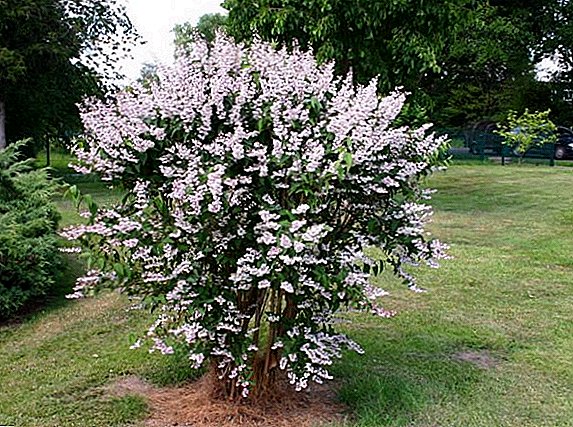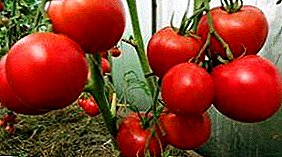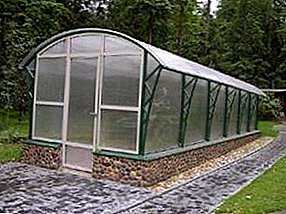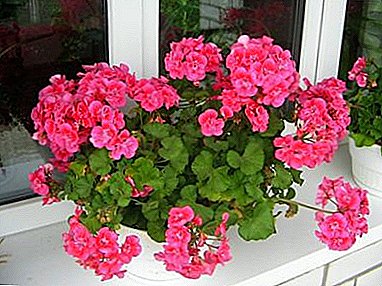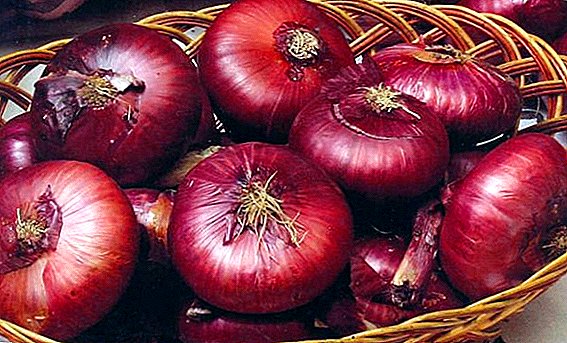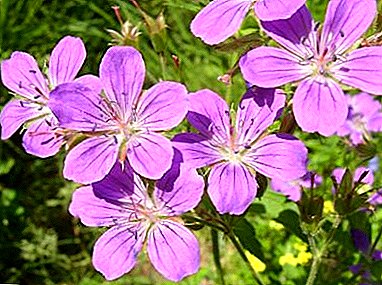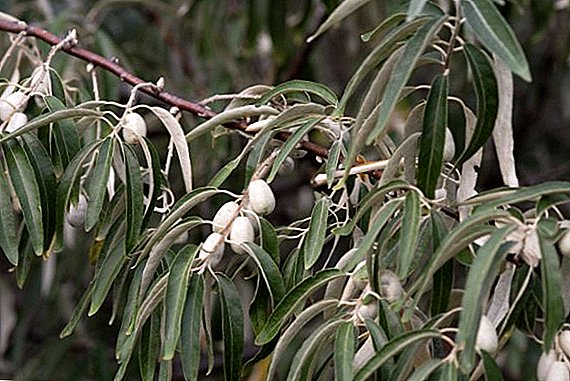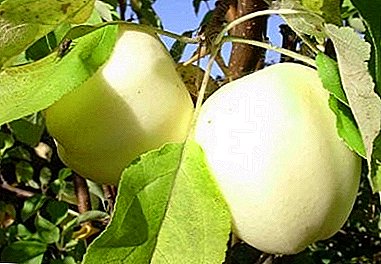
Apple tree variety Nadezhda - quite a popular variety.
Possesses high productivity and good taste of fruits.
The ease of the average, in the care of quite unpretentious.
What kind is it?
 The grade Nadezhda is an autumn grade of an apple-tree.
The grade Nadezhda is an autumn grade of an apple-tree.
Fruits reach maturity in the beginning - mid-September. Hope is a frost-resistant type of apple trees.
Fruits have a high storage time, with proper care do not spoil up to 90 days, that is, they can lie until mid-December.
IMPORTANT! Place the apple crop in a dark, cool place, away from the potatoes.The longest will be stored in the cellars and basements.
Insulate the boxes are not required, but watch out for moisture - with increased fruit may begin to rot.
Pollination
The variety of apple trees Hope is pollinated, for successful fruiting it is necessary to plant one of these varieties:
- Zhavoronkova
- Miass
- Memory and Anis Purple
Description grade Hope
 The apple tree of the Nadezhda variety is a tree distinguished by its tallness and rather small fruits. Growth is high, the shape of the crown - rounded, pyramidal.
The apple tree of the Nadezhda variety is a tree distinguished by its tallness and rather small fruits. Growth is high, the shape of the crown - rounded, pyramidal.
The bark is dark brown on the main branches and trunk. The leaves of Hope are egg-shaped, rather large in size, and have finely perched edges.
Buds appear in the flowering period, they are also large, slightly tinted pink in color.
Small, smaller than average, shape - rounded flat. The surface is smooth and dry, the skin is quite thin.
The color of the ripe fruit is greenish-yellow, in places there is a blurred crimson blush, at the time of ripening it covers the entire fruit. The flesh of the apple is a light beige color, juicy, with a sweet-sour flavor.
The chemical composition of the fetus:
- 10.1% sugars;
- 27 mg / 100g ascorbic acid;
- 13.8% soluble solids;
- 1.1% titrated acids.
A photo
On the photo are the fruits of the apple "Hope":

Breeding history
The apple tree variety Nadezhda was created artificially, by crossing the apple tree variety Borovinka of the Ural ridge.
The authors are: PA Zhavoronkov and MA Mazunin - employees of the South Ural Research Institute for Horticulture and Potato.
Natural growth region
It has a fairly wide range of growth, feels most comfortable in the Urals region, where it was zoned in 1988It is adapted to severe frosts, but it feels best in temperate latitudes.
Yield
 The apple tree of the Nadezhda variety is capable of producing crops for 5-7 years of life. At first it bears fruit regularly, but soon the yield becomes irregular, periodic.
The apple tree of the Nadezhda variety is capable of producing crops for 5-7 years of life. At first it bears fruit regularly, but soon the yield becomes irregular, periodic.
Fruit ripening and the ability to harvest occurs in the first half - mid-September.
With proper care, you can harvest up to 85 kilogram from one plant.
Fruits lend themselves well to processing, most actively used for home canning.
Planting and care
In order for your tree to actively bear fruit and produce large volumes of harvest, you need to follow a few simple requirements.
The most optimal period for planting an apple of the Nadezhda variety is autumn.
At this time of year it is much easier for a tree to take root in a new place. The tree rests during the winter, and from the spring it is already beginning active growth.
If the cold comes earlier, the tree may die, as it does not have time to settle down.
When choosing a place, be sure to keep in mind that the distance between the trees should not be less than 4 meters. If you plant closer, the apple trees will interfere with each other.
 If the trees in your garden grow in rows, make sure that there is a minimum distance of 4.5 meters between them (rows).
If the trees in your garden grow in rows, make sure that there is a minimum distance of 4.5 meters between them (rows).
After you track the distance between the landing pits, you can start creating footprints.
Dig a hole. The depth should be about 70 cm, diameter - 100-115 centimeters. Fertilizers are mixed with loosened soil. The pit should eventually become a mound.
Important: elevation above the ground should not exceed 15-20 cm
Drive a peg into the center of the hill - it will serve as a support for your seedling. The tree is put on a hill, sprinkled with earth and tamped. Abundantly watered.
An important part of caring for an apple tree is pruning branches. It is made after the winter, when the frost was asleep.
If an apple tree is older than seven years, then the upper shoots are pruned first. If the seedling is younger, the shoots should not be cut.
At any age of the tree, carefully remove the damaged branches and areas, as well as last year’s leaves (if they were not removed before winter), as the old and unsuitable parts may rot, and later become a haven for the pathogenic bacteria.
Remember: only those annual growths are cut, which either grow upwards or inside the crown.Carefully remove weeds that grow during the warm period at the foot of the apple tree.
Sometimes loosen the ground around an adult tree.
Diseases and pests
Green aphid
 Colonial pest. It multiplies quickly, with the onset of spring in the first days of warmth can capture all the young shoots that your plant has given.
Colonial pest. It multiplies quickly, with the onset of spring in the first days of warmth can capture all the young shoots that your plant has given.
Aphid sucks the juice from the sprouts, because of which flowers and, accordingly, fruits do not appear on those.
Treatment: excellent resistance to ladybugs. They are sent to the places where the pest colonies have settled. Cows eat pests as soon as possible. You can also spray the tree with tobacco-soap decoction.
Apple Mole
When the flowering stage begins, these pests infect many apple trees. Caterpillars moth overwinter on shoots or bark of branches, with warming they wake up and feed on foliage and flowers.
On eaten leaves parasites build nests and pupate.
Treatment: before and after flowering, sprinkle the shoots and branches with a seven percent solution of chlorophos and a two percent solution of solone.
Scab
The apple tree of the Nadezhda cultivar is sufficiently resistant to scab, but still sometimes it becomes infected with this disease. The scab is a fungus whose pathogen spends the winter on the bark or dead foliage, and in the spring affects the plant.
Greenish spots are formed on foliage, brown on fruits. If you do not treat the scab in time, the foliage begins to fall off, and the fruit shrinks.
Treatment: Always burn fallen leaves outside the garden, then spray the earth with a 3% nitrafen solution. Buds wash one percent Bordeaux liquid.
Black cancer
It affects the trunk, leaves, fruits and branches. It expresses either in ulcers or in black-brown growths, the affected parts of the tree dry up, the bark begins to fall off.
If time does not provide proper treatment, the tree with this disease lives for a maximum of three years.
Treatment: Cut the affected bark and branches with a sharp knife. Treat bark wounds with one percent Bordeaux liquid. Also spray the solution with buds before flowering.
IMPORTANT! If you find an infection on one of the trees, apply preventive measures to the entire garden, otherwise the disease may spread.
TIP: Carefully clean the garden before winter, as most pathogens overwinter on fallen leaves.
 An apple-tree of a grade the Hope to hold is not more difficult, than any other grade.
An apple-tree of a grade the Hope to hold is not more difficult, than any other grade.
It has a high yield, the fruits are well processed.
This tree is suitable not only for the nursery, but also for the usual private garden.
But the variety also has disadvantages: Hope has irregular yields and needs a pollinator tree.



